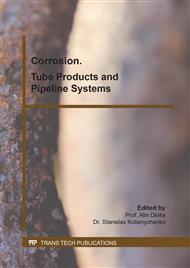[1]
H Liu, X.H Pei, K Luo, Current status and trend of separated layer water flooding in China, Petro. Exp. and Dev. 40(2013) 733-740.
Google Scholar
[2]
H Liu, X.H Pei, D.L Jia, Connotation, application and prospect of the fourth-generation separated layer water injection technology, Petro. Exp. and Dev. 44(2017) 608-613.
DOI: 10.1016/s1876-3804(17)30073-3
Google Scholar
[3]
Y.L Zhang, L Han, X.L Song, Stress corrosion cracking behavior of austenitic stainless steel in sulfur containing waste water, Corros. Sci and Prot Tec. 30(2018)513-519.
Google Scholar
[4]
J.D Wang, X Chen, Z.B Wang, Corrosion behavior of Q235 steel in sour water, Cor. Sci and Pro. Tec. 9(2017) 485-490.
Google Scholar
[5]
Y Ma, P Ren, B.N Niu, Corrosion characteristics of produced water with high sulfide in northern Shaanxi, Corros. Sci and Prot Tec. 29(2017)27-36.
Google Scholar
[6]
D.X Han, Y.G Xie, X.J Tian, Corrosion and scaling control for tubing and casing in Sewage reinjection well, Corros. Sci and Prot Tec. 27(2015)397-404.
Google Scholar
[7]
T Wang, S.L Yang, W.H Zhu, Law and countermeasures for the casing damage of oil production wells and water injection wells in Tarim oilfield, Petro. Exp. and Dev. 38(2011)352-360.
DOI: 10.1016/s1876-3804(11)60038-4
Google Scholar
[8]
G.Q Zhang, M Chen, Y.D Geng, Casing damage mechanism in sand producing formations, Petro. Exp. and Dev. 32(2005) 112-118.
Google Scholar
[9]
H.J Yang, H Pan, Y Zhang, Corrosion inhibition effect of de-oxygenation on down-hole string of air foam flooding process and de-oxygenation limit, Acta Petro Sin. 40(2019)99-108.
Google Scholar
[10]
G.Z Liao, H.J Yang, Y.W Jiang, Application scope of oxygen-reduced air flooding and the limit of oxygen content, Petro. Exp. and Dev. 45(2018)105.
Google Scholar
[11]
Preparation, Installation, Analysis, and Interpretation of Corrosion Coupons in Oilfield Operations, NACE Standard RP0775-2005, Item No.21017.
Google Scholar
[12]
Z Zhang, Z.W Liu, Y.H Xie, Influence of shaft load-corrosion coupling on the service life of carbon steel casing pipe, Acta. Petro. Sin. 38(2017) 342-349.
Google Scholar
[13]
S Guo, E.H Han, H.T Wang, Life prediction for stress corrosion behavior of 316L stainless steel elbow of nuclear plant, Acta. Metall. Sin. 53(2017) 455-461.
Google Scholar
[14]
P.L Ge, G Lin, X.L Zhang, Review of down hole tubing corrosion of water/gas injection well and anti-corrosion measures, Cor. Sci and Pro. Tec. 30(2018)324-330.
Google Scholar
[15]
G.X Zhao, Y.Y Wang, Y.X Lu, Corrosion behavior of Q345R steel in simulated high mineralization waters, Cor. Sci and Pro. Tec. 30(2018) 468-473.
Google Scholar



